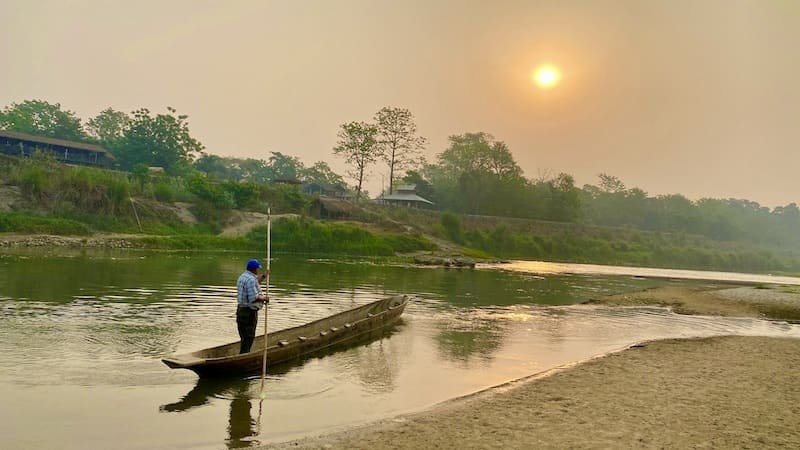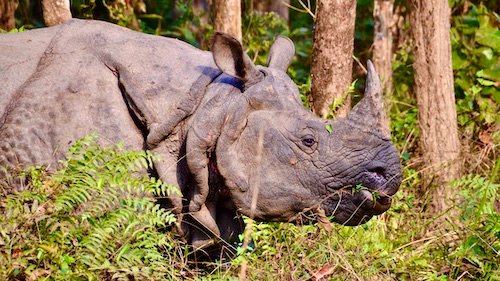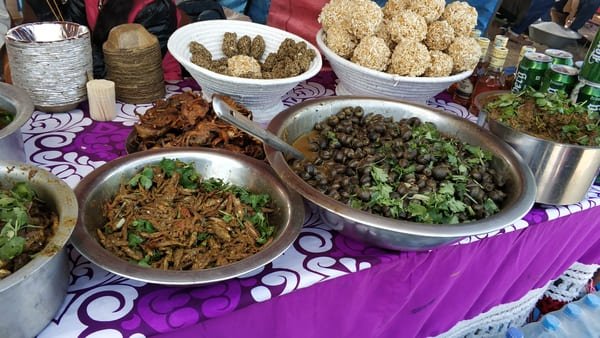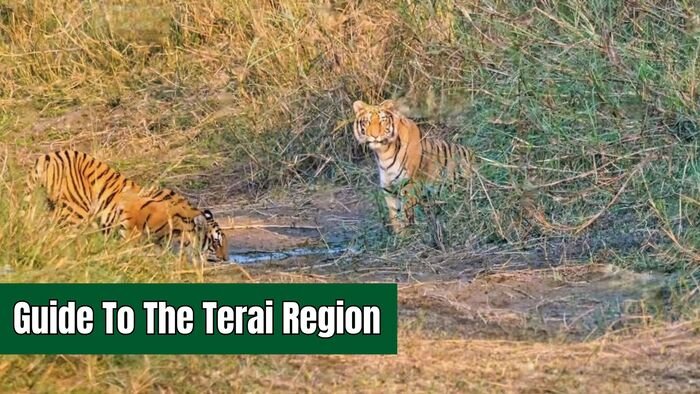Nepal is known for its mountains, however a considerable part of the country, particularly the Terai region, features flatlands, plains, and lush forests near the Indian border. The Terai is also the sacred birthplace of Buddha and boasts culturally rich towns.
While Chitwan National Park is a notable exception, many travelers to Nepal remain unfamiliar with this region. Historically, the Terai, characterized by dense forests and malarial marshes, served as a natural border between the plains of North India and Nepal’s hills and mountains. This continued until the mid-20th century. Over centuries, it played a crucial role in the development of Hinduism, hosting kings, queens, and mythological deities.
Today, Terai is a hub for Nepal’s agriculture industry, as well as home to some of its remarkable national parks. This guide to the Terai Region covers hidden gems and tips for an unforgettable experience.
History of The Terai Region

The historical jungle barrier that once shielded Nepal from Indian influences, much like the Himalayas in the north, has now disappeared. This disappearance has given way to an unmistakable Indian influence in the Terai region. This transformation is evident in the bustling border bazaars, the cultural practices such as the presence of mosques, as well as the industrial landscape featuring jute mills and sugar refineries.
Despite these changes, the Western Terai has preserved substantial portions as national parks and reserves. It has established itself as among the premier wildlife and bird havens in the subcontinent. Dense riverine forests provide cover for predators like tigers and leopards, and swampy grasslands offer an ideal habitat for rhinos.
Chitwan is a popular choice, but quieter options like Bardia and Sukla Phanta to the west provide a more serene experience for those willing to venture further. Additionally, the region boasts historical significance, as Lumbini, the birthplace of Buddha, is located here, along with important archaeological discoveries at Tilaurakot.
Foreigners have access to four border crossings in the western Terai, with Sonauli being the most frequented due to its location on the direct route between Kathmandu and Varanasi. Other crossing points south of Nepalgunj or Dhangadhi are less popular, while Mahendra Nagar, on the far western frontier, offers a more direct route from Delhi.
When Is The Best Time To Visit The Terai?
The best time to visit the Terai region is from October to January when the weather is pleasantly mild, with the latter half of this period experiencing cooler nights and mornings. Wildlife viewing is enhanced after the thatch has been cut, typically from late January, as temperatures start to rise. Dashain and Tihar which fall in the month of October is something you wouldn’t want to miss out on.
The months of April, May, and June bring intense heat, while July to September sees the onset of the monsoon, bringing mosquitoes, malaria, and leeches. During this period, minor unpaved roads may become muddy and difficult to traverse, and some rivers may overflow their banks.
How to Reach The Terai Region?
Reaching the Terai Region is facilitated by various transportation methods, offering travelers flexibility in choosing their preferred mode of travel:
1. Flight:
One common and efficient option is air travel, with flights available to major cities in the Terai such as Bhairahawa, Bharatpur, and Biratnagar. These cities have airports that serve as gateways to the region. Airlines operating domestic flights within Nepal connect these cities to major hubs like Kathmandu and Pokhara.
2. Tourist Bus/ Jeep:
Road travel is another viable and cheaper option. Travelers opt for buses from Kathmandu or Pokhara to reach the Terai Region. The road routes offer an opportunity to witness the foothills of the Himalayas to the flat plains of the Terai.
While the majority of travelers to Nepal typically arrive via international flights into Kathmandu, an alternative route is to travel by land from India, passing through the Terai region.
For journeys between Kathmandu or Pokhara and Terai cities, opting for a flight proves to be the most comfortable choice. Spending only 30 to 60 minutes in the air significantly trims down travel time compared to enduring hours of traffic jams and discomfort experienced in bus journeys.
Top Activities To Do in the Terai Region

While you are in this region you won’t want to miss out on these places to visit:
1. Chitwan National Park:
Established in 1973, Chitwan stands as Nepal’s inaugural national park, encompassing vast areas of forest, grasslands, and marshes. This expansive protected region teems with diverse wildlife, including rare slender-snouted gharial, deer, elephants, tigers, and the iconic one-horned rhinoceros. Chitwan has witnessed a remarkable resurgence in rhino populations, with over 600 of these magnificent creatures thriving in the park, thanks to successful anti-poaching campaigns.
Boasting one of the highest concentrations of Royal Bengal tigers globally, spotting these elusive predators proves challenging. Chitwan’s accessibility makes it Terai’s most popular national park, easily reached by car or bus from both Kathmandu and Pokhara. Alternatively, a 20-minute flight from Kathmandu to Bharatpur Airport provides a swift option, while those seeking a more rugged yet scenic experience can embark on a five to seven-hour overland journey.
For a comprehensive guide, discover the best things to do in Chitwan to make the most of your visit!
2. Bardia National Park:
Bardia National Park, situated in far western Nepal, is often described as reminiscent of Chitwan. Due to its challenging accessibility compared to Chitwan, Bardia attracts fewer visitors, offering a more secluded experience with limited accommodation options. The park’s natural setting allows for wildlife sightings in a rugged environment, making encounters with tigers more likely than in Chitwan.
Bardia boasts diverse habitats, ranging from dry slopes to grassy plains. The establishment of Banke National Park in 2010 along Bardia’s eastern border has created the largest tiger conservation area in Asia. It provides a habitat for not only tigers but also rhinos, spotted deer, Ganges dolphins, and more.
For travelers aiming to reach Bardia, flying to Nepalganj airport is the most convenient option. From there, a three-to-four-hour bus journey connects to the park. While buses from Kathmandu are available, they are not recommended.
3. Koshi Tappu Wildlife Reserve:
Situated on the eastern Terai of Nepal, the Koshi Tappu Wildlife Sanctuary beckons bird enthusiasts with its rich biodiversity. This wetland area is a haven for nearly 500 bird species, encompassing storks, ducks, geese, eagles, terns, lapwings, and kingfishers. The sanctuary also hosts a diverse array of fish, as well as elephants, deer, and the elusive Ganges dolphin. The predominant terrain comprises mudflats, reed beds, and freshwater marshes, creating an ideal habitat for wildlife.
Specifically designed tented camps cater to bird watchers, providing an immersive experience in the heart of the sanctuary. For travelers, the Koshi Tappu Reserve is conveniently located approximately a 90-minute drive from Biratnagar Airport in eastern Nepal. While buses from Kathmandu are an option, the journey takes a minimum of 12 hours, making air travel a more time-efficient choice.
4. Lumbini:
Located 22km west of Bhairahawa, is the revered birthplace of Buddha, holding profound significance for the world’s one billion Buddhists. This historical site, protected by the Ancient Monument Preservation Act 1956, is managed by the Lumbini Development Trust. It stands as the epicenter of Nepal’s crucial archaeological discoveries dating back to the third century BC.
The UNESCO World Heritage Site, has sacred grounds with eastern and western monastic zones, including Theravadin, Mahayana, and Vajrayana monasteries. The meticulously planned Master Plan, developed with the United Nations in 1972-1978 by Prof. Kenzo Tange, ensures the preservation of this spiritual hub.
Today, Lumbini boasts monasteries and Buddhist centers representing diverse international architectural traditions. Accessible by flying to Bhairahawa from Kathmandu or a five-hour drive from Pokhara, Lumbini remains a major pilgrimage site for Buddhists worldwide.
5. Janakpur:
Janakpur, also known as Janakpurdham, holds ancient significance as a Hindu pilgrimage site. Legend has it that Janakpur is the birthplace of Sita, the wife of Hindu Lord Rama, also known as Janaki.
A notable attraction is the Janaki Mandir temple, a unique blend of Mughal and Rajput design, setting it apart in Nepal. For enthusiasts of Nepali art, a visit to the Janakpur Women’s Development Centre is a must. Situated on the city’s outskirts amid farmland, this center showcases the vibrant and stylized traditional paintings created by local Maithili women. The artwork is now a profitable venture available at fair trade and handicraft shops in Kathmandu.
Adding to its charm, Janakpur serves as the terminus for Nepal’s sole passenger railway line connecting Jainagar and Janakpur. While not a major attraction, railway enthusiasts may not want to miss it!
6. Sukla Phanta Wildlife Reserve
In Nepal’s far southwest, the expansive natural grasslands known as “phanta” bear a striking resemblance, albeit on a smaller scale, to the savannas of East Africa. The Sukla Phanta Wildlife Reserve, interspersed with these grasslands, offers a safari-like experience and is located south of Mahendra Nagar. The park historically faced challenges in access, and the civil war further isolated it, resulting in minimal visitor traffic.
Sukla Phanta is known for having lots of swamp deer, sometimes in groups of a thousand or more. It also has wild elephants and several rhinos. Unfortunately, the tiger population has dwindled significantly due to poaching, marking a downturn for a park that once boasted one of Asia’s highest densities of tigers.
Despite these challenges, Sukla Phanta remains a haven for bird enthusiasts, with an impressive count of 470 species! It also includes rare ones like the Bengal florican and the giant hornbill.
Local Cuisine of Terai Region

The Terai Region’s cuisine is rich and diverse, reflecting the cultural amalgamation of Indian and Nepali influences. Here are some local dishes you must try during your culinary journey in the Terai Region:
1. Tharu Food
The traditional dishes are often prepared with locally sourced and seasonal ingredients. From aromatic curries like the Ghonghi to Sikarni, the indigenous desserts, Tharu cuisine provides a compelling reason to savor the authentic flavors of this vibrant region.
2. Sidu (Steamed Wheat Bread)
A steamed bread made from wheat flour, Sidu is a beloved dish in the Terai Region. It’s typically served with ghee (clarified butter), lentils, or meat curries, making it a wholesome and flavorful meal.
3. Pakhala (Fermented Rice Dish)
This is a cooling rice-based dish, perfect for the warm climate of the Terai. Pakhala is fermented rice soaked in water and served with various accompaniments like pickles, curd, and green leafy vegetables.
4. Tarul Tarkari (Yam Curry)
The Terai Region is known for its use of locally grown ingredients, and Tarul Tarkari is a prime example. This curry features yams cooked with a blend of spices, creating a delicious and hearty dish.
Key Takeaway: Travel Guide To The Terai Region
The Terai region welcomes you with its diverse landscapes, rich cultural tapestry, and unique attractions. From the wildlife havens of Chitwan and Bardia to the spiritual sanctuaries of Lumbini and Janakpur, the Terai offers a multifaceted experience for travelers seeking adventure, cultural immersion, and natural beauty.
Whether exploring the lush jungles, enjoying the vibrant festivals, or indulging in local food, a journey through the Terai unfolds as a captivating odyssey. As you plan your visit, consider the seasons, accessibility options, and the array of activities that cater to your interests. Ultimately, a trip to the Terai Region is a holistic experience, seamlessly blending natural beauty, cultural heritage, and gastronomic delights.
